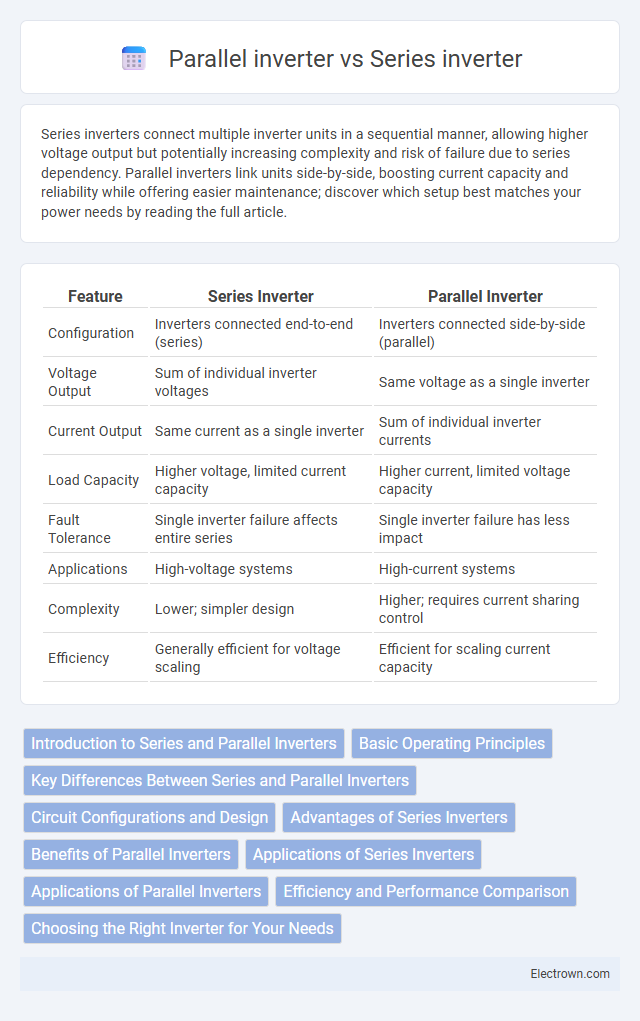Series inverters connect multiple inverter units in a sequential manner, allowing higher voltage output but potentially increasing complexity and risk of failure due to series dependency. Parallel inverters link units side-by-side, boosting current capacity and reliability while offering easier maintenance; discover which setup best matches your power needs by reading the full article.
Table of Comparison
| Feature | Series Inverter | Parallel Inverter |
|---|---|---|
| Configuration | Inverters connected end-to-end (series) | Inverters connected side-by-side (parallel) |
| Voltage Output | Sum of individual inverter voltages | Same voltage as a single inverter |
| Current Output | Same current as a single inverter | Sum of individual inverter currents |
| Load Capacity | Higher voltage, limited current capacity | Higher current, limited voltage capacity |
| Fault Tolerance | Single inverter failure affects entire series | Single inverter failure has less impact |
| Applications | High-voltage systems | High-current systems |
| Complexity | Lower; simpler design | Higher; requires current sharing control |
| Efficiency | Generally efficient for voltage scaling | Efficient for scaling current capacity |
Introduction to Series and Parallel Inverters
Series inverters connect multiple power sources end-to-end, increasing the output voltage by summing the voltages of each source, while parallel inverters link power sources side-by-side to maintain voltage and increase current capacity. Your choice between series and parallel inverters depends on the desired voltage level and load current requirements for efficient power conversion. Understanding the core structural differences ensures optimal system design for applications ranging from solar power to uninterruptible power supplies.
Basic Operating Principles
Series inverters connect solar panels or DC sources in series, increasing the voltage while maintaining current to convert DC to AC efficiently. Parallel inverters link DC sources in parallel, combining currents at a consistent voltage to achieve inverter output, improving redundancy and system reliability. Both operate by switching power electronics like IGBTs or MOSFETs to synthesize AC waveforms from DC inputs but differ in their voltage and current management approaches.
Key Differences Between Series and Parallel Inverters
Series inverters connect multiple power modules end-to-end, resulting in higher output voltage with consistent current, while parallel inverters link modules side-by-side to increase output current at a stable voltage. Series inverters are ideal for high-voltage applications requiring efficient voltage stepping, whereas parallel inverters excel in scenarios demanding high current capacity and redundancy. The key differences lie in their electrical configuration, impact on voltage and current output, and suitability for specific load requirements.
Circuit Configurations and Design
Series inverters connect power devices sequentially, enabling higher voltage handling by sharing voltage stress across components, which suits high-voltage applications but requires careful balancing and synchronization. Parallel inverters arrange power devices side-by-side, dividing current load evenly to enhance reliability and increase current capacity, ideal for high-current, low-voltage scenarios with simpler voltage control. Design considerations for series inverters emphasize voltage isolation and equal voltage sharing, while parallel inverter design focuses on current sharing and minimizing circulating currents through matched device characteristics and proper gate drive circuitry.
Advantages of Series Inverters
Series inverters offer improved efficiency and enhanced power handling by allowing voltage addition from each inverter module, making them ideal for high-voltage applications. Their modular design increases system reliability and simplifies maintenance by isolating faults without shutting down the entire system. These inverters provide better fault tolerance and scalability compared to parallel inverters, enhancing overall performance in renewable energy and industrial power systems.
Benefits of Parallel Inverters
Parallel inverters offer enhanced reliability and scalability by allowing multiple units to share the load, ensuring continuous power supply even if one inverter fails. Your system benefits from increased efficiency and reduced downtime, as parallel configurations enable easy maintenance and expansion without interrupting operations. This setup is particularly advantageous for large-scale renewable energy installations requiring flexible power management and improved overall performance.
Applications of Series Inverters
Series inverters are predominantly used in applications requiring high voltage output, such as in medium-voltage uninterruptible power supplies (UPS) and photovoltaic systems where multiple inverters are connected in series to achieve the desired voltage level. These inverters are ideal for industrial motor drives and electric traction systems, where precise voltage control and scalability are essential. Their ability to handle high-voltage applications with improved efficiency distinguishes them from parallel inverters, which are more suited for high current, low voltage scenarios.
Applications of Parallel Inverters
Parallel inverters are widely used in applications requiring high power output and redundancy, such as in large-scale renewable energy systems and uninterruptible power supplies (UPS). Their ability to share load current evenly enhances system reliability and scalability in industrial motor drives and grid-tied solar power installations. Parallel inverter configurations also support seamless fault tolerance and easier maintenance compared to series inverters.
Efficiency and Performance Comparison
Series inverters typically offer higher efficiency in low to medium power applications due to reduced switching losses, while parallel inverters excel in high power scenarios by distributing load evenly across multiple modules, enhancing reliability and scalability. Performance-wise, series inverters provide smoother output waveforms with fewer harmonic distortions, whereas parallel inverters achieve better fault tolerance and maintenance flexibility through modular design. Selecting between series and parallel inverters depends on specific efficiency requirements and the operational complexity of the power system.
Choosing the Right Inverter for Your Needs
Choosing the right inverter depends on your power requirements and system configuration; series inverters are ideal for applications needing high voltage output and efficient energy transfer, while parallel inverters provide flexibility in power scaling and redundancy. Your choice should consider load capacity, voltage compatibility, and system expansion potential to optimize performance and reliability. Understanding these key differences ensures your inverter aligns with the specific demands of your renewable energy or backup power system.
Series inverter vs Parallel inverter Infographic

 electrown.com
electrown.com